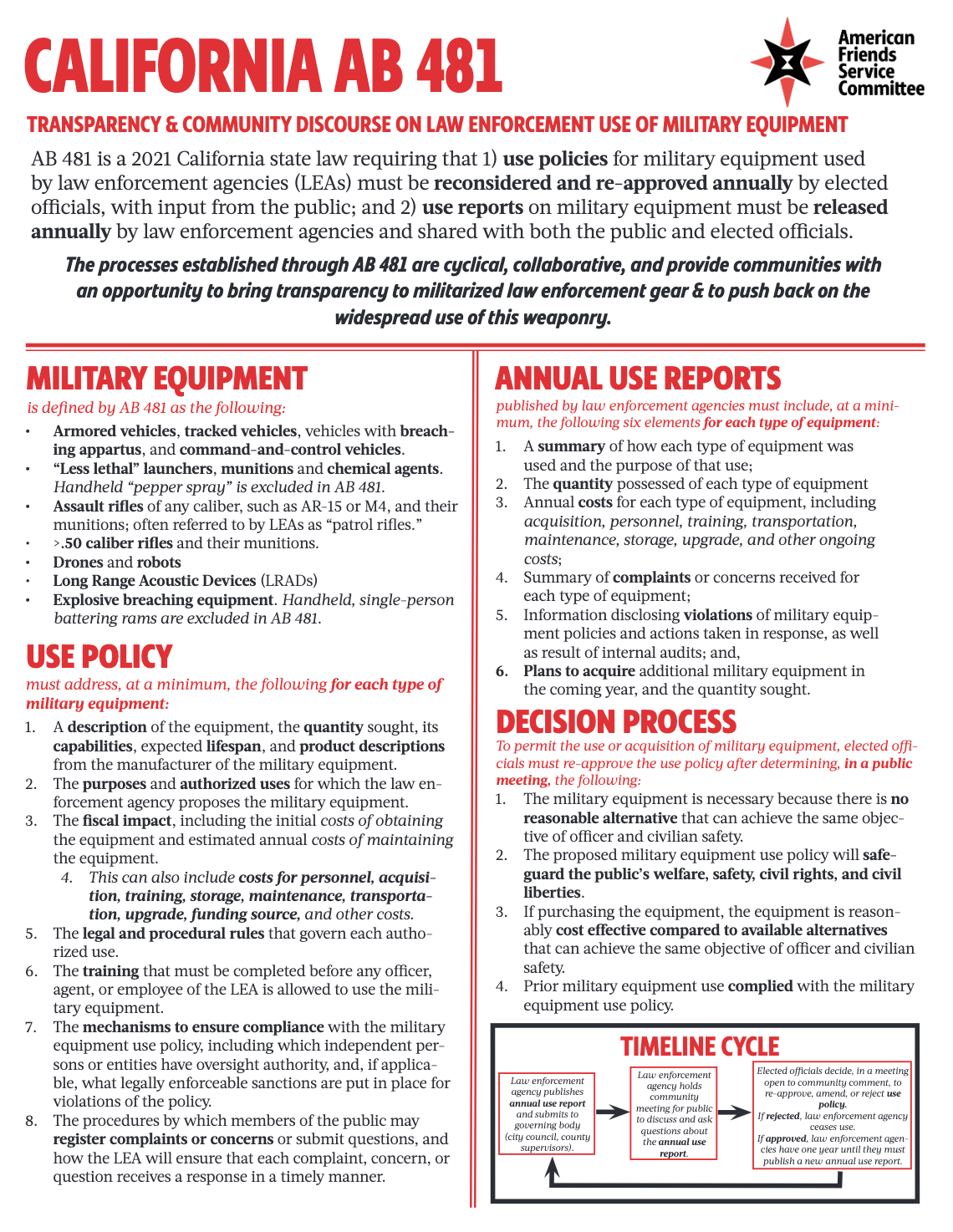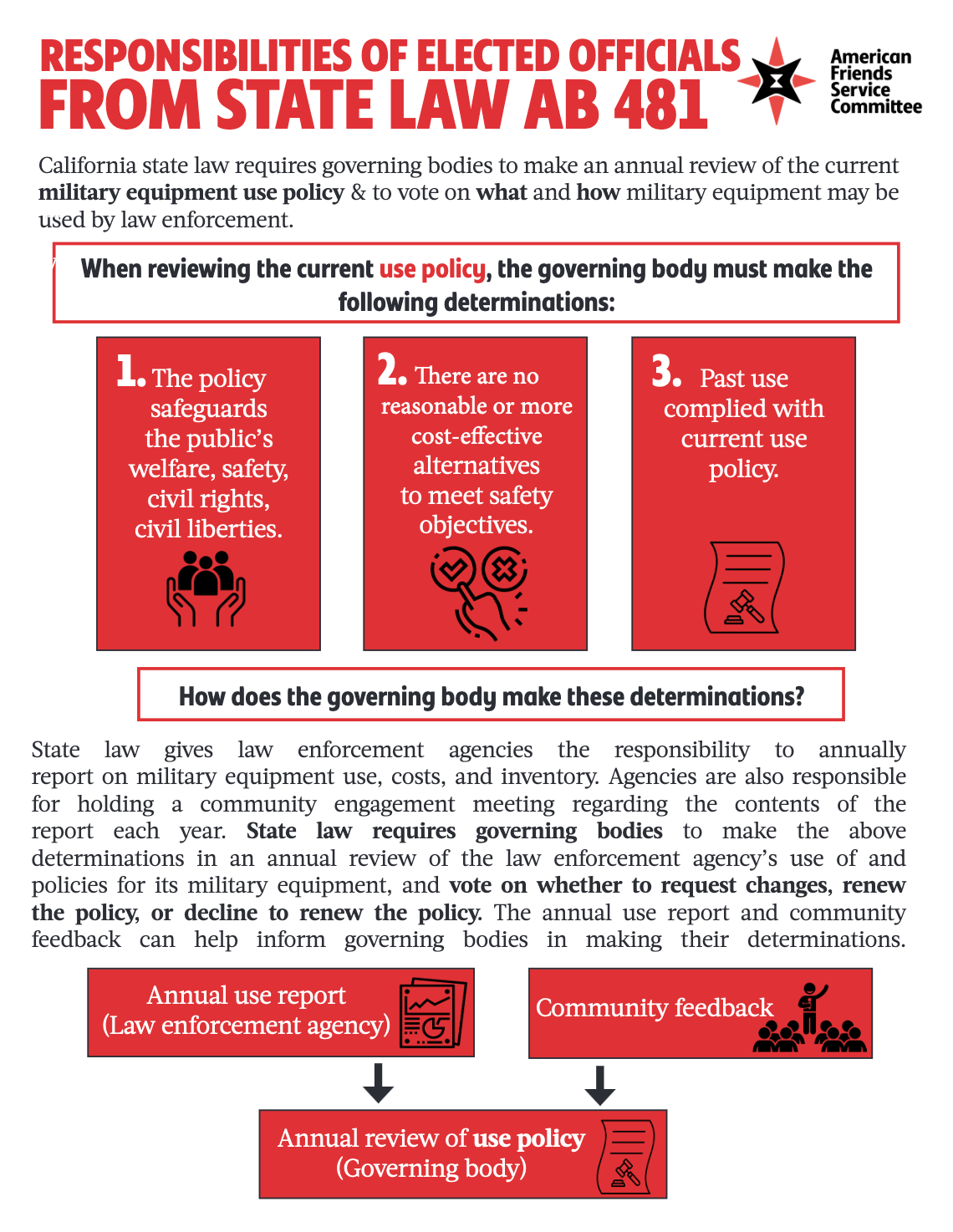AB 481 Transparency Advocacy Toolkit
How does police militarization impact our communities? Who is impacted by police militarization? What is the full fiscal impact of police militarization? Transparency advocacy can expose the harms and costs caused by police militarization.
Why transparency advocacy is important
Transparency in police use of and spending on militarized equipment can help communities understand how military equipment is used in their communities, who is impacted by that use, and the cost of militarization. This understanding can inform advocacy efforts. Transparent reporting on use helps communities expose misuses of military equipment by law enforcement.
In California, this transparency is aided by state law AB 481, which requires all law enforcement agencies in California to annually publish a report on the uses and fiscal impact of military equipment, as defined in AB 481. This applies to military equipment acquired through any source, including purchases, Defense Department surplus, state or federal grants, or borrowing from other agencies. The reports must be published to and remain on the agency's website for as long as the agency is using that military equipment. In addition, agencies must hold a well-publicized community meeting to share and hear from community on the agency's use of military equipment. These annual use reports inform City Councils and County Boards of Supervisors, which are required to review the agency's use policies for military equipment on an annual basis.
Common transparency issues
While each community and law enforcement agency are unique, there are several common transparency issues AFSC has identified across California law enforcement agencies. Complying fully with state law AB 481 would resolve many of these transparency issues.
Law enforcement agencies are required to post both their military equipment use policy and their annual use reports on the agency's website for as long as the military equipment is available for use. If you are unable to find both the use policy and the annual use report, this is where you can start your transparency advocacy.
State law AB 481 requires use policies to include information needed for your community to be informed. For each type (model) of military equipment, law enforcement agencies are required to report the manufacturer, quantity, authorized uses, and fiscal impact. (Please see AFSC's AB 481 explainer for the full list of requirements.) If you are unable to find any of these attributes of military equipment, this is a good place to begin your transparency advocacy.
The information is important: The quantity can indicate the agency is stockpiling or is armed to the teeth. Different models of impact projectiles show whether they are indiscriminate 'scattershot' weapons. Purchase costs (together with reporting on personnel costs) help measure how else those funds could be spent.
Were assault weapons fired one time, or one hundred times? Were "less lethal" weapons used only against people experiencing mental health crisis? How much is the full cost to the city for maintenance (including personnel time) on the "free" drones or other equipment that police received?
Annual reports are required to include a summary of uses, purposes for use, and all fiscal costs (including acquisition, maintenance, training, personnel, and upgrades) for military equipment owned by a law enforcement agency. When any of that information is missing, it is not possible for communities to understand the impact of military equipment on their city or county. If the true annual costs for drones, armored vehicles or assault rifles could fund six more K-12 teachers and classrooms, communities should be empowered to understand and consider that tradeoff.
Annual use reports are required to include, at a minimum, "a summary of how the military equipment was used and the purpose of its use.". Some agencies do not comply with this requirement.
Use vs Use of Force
Some agencies narrow their reporting down to "use of force", rather than use, even though AB481 never refers to use of force. If no physical attack or injury or death can be traced back to a weapon, some agencies do not include this information. For example, agencies with this approach would not report if law enforcement officers are pointing assault weapons point blank without firing the weapon.
Deploy, Display, Discharge
AFSC advocates for reporting on the three "D"s: deploy, display, discharge. A weapon that is sent into the public has been deployed, and that use should be reported. A weapon that is brandished has been displayed, and that use should be reported. And if a weapon that is fired has been discharged, and that use should be reported. <<not sure of purpose of last sentence - all agencies are reporting discharges, right?>>
State law makes some exceptions for common weapons, such as hand-held pepper spray, or for "standard issue service weapons and ammunition of less than .50 caliber that are issued" to law enforcement officers. Some law enforcement agencies have declared assault rifles (often called "patrol rifles") as standard issue. For example, San Francisco PD has over 300 assault rifles whose existence it refuses to report. But as one activist in Santa Cruz pointed out, assault weapons cannot be standard issue if they are not carried by foot patrol, bicycle cops, or motorcycle cops. All assault weapons should be included in both use policies approved by governing bodies and in annual use reports.
The harms of police militarization fall disproportionately on Black and Brown people, and increased transparency in reporting can expose this disparity. While state law does not require reporting on where and when military equipment is used, elected officials can require this reporting, and communities may choose to advocate for it. Some agencies may report by area or beat, and some agencies may report by address or closest intersection. The best transparency we've seen comes from Oakland Police, which released a spreadsheet with dates, locations, and a brief description of incidents of military equipment use.
How to identify advocacy issues
While the above are common transparency issues, there may be issues that are more important to your community. We encourage you to consider what missing information your communities and neighborhoods may be missing that may impact your understanding of how your city and county invests in its residents.
How to advocate for transparency
Who, when, and how transparency advocacy can happen
These are the two bodies that can change transparency in annual reports: the City Council or County Board of Supervisors (which holds an annual review process for policy and use) and the police (who publish the annual use report).
Because the AB 481 process follows an annual process, there are key points throughout the year for different forms of transparency advocacy.
All annual reports are required to be posted on the police agency's public website for as long as the military equipment is available to use, and police are required to describe how members of the public may ask questions, make comments, or complain about the agency's use of military equipment.
Good activities for this period:
- Study past annual use reports to understand what militarization looks like, and identify what transparency is lacking
- Identify neighbors and community organizers who may support transparency advocacy and/or policy advocacy
- Reach out to the police to request they remedy the non-compliance in their upcoming report
- Reach out to elected officials to brief them on state law requirements, raise your concerns, and request their support in directing police to remedy any non-compliance with transparency requirements
Within 30 days of releasing an annual report, police are required to hold a "well-publicized and conveniently located community engagement meeting, at which the general public may discuss and ask questions regarding the annual military equipment report and the law enforcement agency’s funding, acquisition, or use of military equipment." This meeting is a good place to ask questions about the report, and to request changes in how transparent the use report was.
Good activities for this period:
- Compare the new use report with past use reports to understand shifts in police militarization
- With neighbors and community organizers, attend and ask questions at the community meeting hosted by the police. Coordinate to ask questions and advocate for transparency or policy improvements.
- Reach out to Councilmembers to brief them on state law requirements, raise your concerns, and request their support in directing police to remedy the transparency non-compliance in the upcoming report
City Councils and County Boards of Supervisors are required to annually review the law enforcement agency's military equipment policy. Most use the publication of the annual use report to determine the timing of this public hearing. The public hearing requires a vote on whether to renew the ordinance, and is the most natural point for the governing body to request changes to policy or reporting.
Good activities for this period:
- Reach out to elected officials to brief them on state law requirements, raise your concerns, and request their support in directing police to remedy the transparency non-compliance in the upcoming report
- With neighbors and community organizers, attend and give public comment at the public hearing where City Council or the Board of Supervisors will vote on whether to renew the ordinance.
Sometimes City Councils may renew an ordinance on the condition that it be amended. If this occurs, it is important to follow up and make sure those instructions are carried out.
Good activities for this period:
- Thank council members or county supervisors who supported your advocacy efforts
- Check in with the police or sheriff about whether they are making the changes in their internal reporting that will be needed for increased transparency in the following year's report. Encourage them to post monthly updates on their website.
- Make plans with neighbors and community organizers for when to reconvene on this issue next year.
AFSC is here to help
AFSC has been following AB 481 implementation across California since the state law first went into effect. We support local communities, with analysis, statewide context, or expert briefings.
If you are a community organizer, please reach out to us for AB 481 support: CAHealingJustice@afsc.org
Resources



